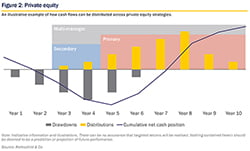Wealth Management: Investment Views – The rise of private markets

William Haggard, William Therlin, Amaya Gutiérrez, Raphaela Schröder and Andreas Doepfert, Wealth Management
Understanding private equity
An interview with Rothschild & Co's Merchant Banking business
Rothschild & Co's Mireille Klitting, Global Partner and Aurelien Bullot, Director of our Merchant Banking division, have multi-decade first-hand experience in investing in private markets.
In the following interview, they provide us with practical insights into the industry and how to invest in private markets' most popular asset class: private equity.
What are the main strategies deployed in private equity?
Mireille Klitting: The main ways to invest in private equity are through primary, secondary or multi-manager strategies.
A primary investment strategy allows clients to commit capital to a General Partner (investment manager) who in turn selects a portfolio of best-in class businesses. These businesses often offer strategic opportunities for the investment manager to make organisational or operational changes.
Examples of such strategies are our Merchant Banking funds, Five Arrows Principal Investments ( FAPI) or Five Arrows Capital Partners ( FACP). These are funds which look to invest in European or US mid-sized businesses to help them grow revenues, increase margins and maintain their competitive advantages vis-à-vis their peers.
In the case of both FAPI and FACP, the funds target a gross internal rate of return of 20%. The trade-off for such returns is that, as with most private equity funds, they are illiquid. This means that clients are liable to pay their full commitment during a fund's term and cannot sell their position. If clients wish to do the latter, they must get the approval from a fund's General Partner and find a buyer on the secondary market.
And what about co-investing?
Mireille Klitting Clients can invest either directly as a co-investor or indirectly (via a primary strategy) as a participant or limited partner in a fund. Where a co-investment opportunity exists, a manager such as Rothschild & Co would hand pick market-leading companies for clients. These companies tend to have good management teams where there is a clear opportunity to directly invest and exit from an underlying business in a four- to five-year timeframe.
Turning to investing on the secondary market, how does this strategy differ?
Mireille Klitting Secondary investment strategies allow clients to buy into an existing portfolio of private equity positions diversified across a number of underlying businesses. Key to this strategy is a manager's ability to:
- Thoroughly analyse and value an existing private equity portfolio of multiple businesses: and
- Deploy market and sectoral insights to help management teams strategically grow their assets
Secondary market opportunities are generally fewer and harder to come by and most clients invest via a dedicated secondary market fund, such as our Five Arrows Secondary Opportunities ( FASO) fund. FASO's diversification across a broad array of businesses at different stages of maturity in a wide variety of geographies often proves attractive for clients. Most importantly, clients like the fact that, in secondary and multi-manager strategies, the investment period is shorter than in primary market strategies. This means that clients usually see returns distributed earlier than in the primary market, as illustrated below.
Click the image to enlarge
You mentioned multi-manager strategies - what are these?
Aurelien Bullot Multi-manager strategies extend the principle of diversification one step further by selecting a blend of primary, secondary and / or co-investment opportunities. Key to the multi-manager strategy is selecting fund managers with a proven business model and strong track record.
Our Five Arrows Private Equity Programme ( FAPEP) fund is an example of this multi-manager strategy investing in top quartile mid-sized funds which are hard to access in Europe, the US and the rest of the world.
From the above strategies, have clients' preferences changed over the last 20 years?
Mireille Klitting Clients have become increasingly attracted to the liquid profile of secondary and multi-manager strategies given that they offer high diversification and therefore a lower risk profile. At the same time, these strategies tend to give investors distributions within a shorter time frame than from the primary market, without much compromise on returns.
Aurelien Bullot A separate trend we have seen in the primary market is increased specialisation by managers as the industry matures. Nowadays, a primary fund is likely to have dedicated sourcing teams looking for new investment opportunities whilst dedicated operating teams will create value from underlying companies by implementing new strategic initiatives.
Private equity has long been perceived as illiquid, is this changing?
Mireille Klitting The rise of the secondary market has changed the face of private equity and created a more liquid forum in which to sell existing holdings.
Increasing numbers of clients have therefore taken advantage of secondary markets to be more actively involved in the management of their portfolios. They now seek to shift their investments sectorally or regionally as opportunities arise, much like when managing a public markets portfolio.
Aurelien Bullot Given increased levels of liquidity, we are also seeing clients become more comfortable with longer investment horizons. This is seen in some long hold funds which were recently launched with an investment cycle of up to 15 years.
Did you know?
The average 10-year cycle of a private equity fund is split into an investment and a divestment period. During the first five years of the fund's life (the investment period), the manager will call on your committed capital as and when businesses are identified to invest in. We call capital committed as and when investment opportunities arise. In the second five years (the divestment period), the manager will start to exit its investments, so as to realise profits and distribute returns to its investors.
Click here to continue: Investment Views - Understanding private debt
In this Investment Views:
-
Foreword
-
Why private markets matter
-
Understanding private Equity (current page)
-
Understanding private debt
-
Managing a direct lending fund
-
Investing with Rothschild & Co
-
Important information
Download the full The rise of private markets in PDF format (1.31 MB)
